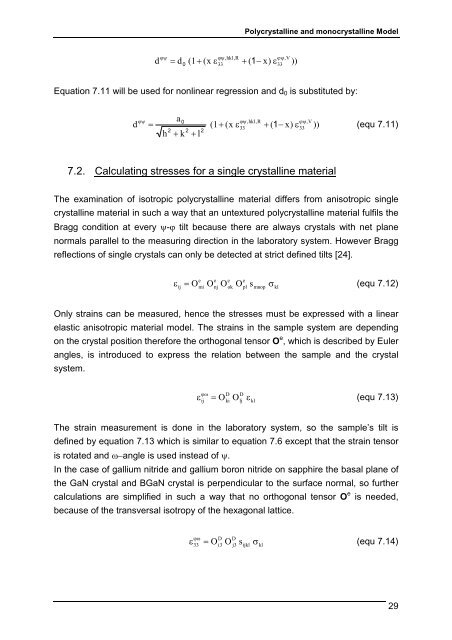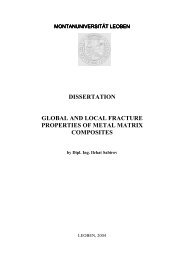Diploma Thesis - Erich Schmid Institute
Diploma Thesis - Erich Schmid Institute
Diploma Thesis - Erich Schmid Institute
Create successful ePaper yourself
Turn your PDF publications into a flip-book with our unique Google optimized e-Paper software.
d<br />
ϕψ<br />
ϕψ,<br />
hkl,<br />
R<br />
= d (1+<br />
( x ε + ( 1−<br />
x)<br />
ε<br />
0<br />
33<br />
Polycrystalline and monocrystalline Model<br />
ϕψ,<br />
V<br />
33<br />
Equation 7.11 will be used for nonlinear regression and d0 is substituted by:<br />
d<br />
ϕψ<br />
a 0 ϕψ,<br />
hkl,<br />
R<br />
ϕψ,<br />
V<br />
= (1+<br />
( x ε33<br />
+ ( 1−<br />
x)<br />
ε33<br />
)) (equ 7.11)<br />
2 2 2<br />
h + k + l<br />
7.2. Calculating stresses for a single crystalline material<br />
The examination of isotropic polycrystalline material differs from anisotropic single<br />
crystalline material in such a way that an untextured polycrystalline material fulfils the<br />
Bragg condition at every ψ-ϕ tilt because there are always crystals with net plane<br />
normals parallel to the measuring direction in the laboratory system. However Bragg<br />
reflections of single crystals can only be detected at strict defined tilts [24].<br />
ε = O O O O s σ<br />
(equ 7.12)<br />
ij<br />
e<br />
mi<br />
e<br />
nj<br />
e<br />
ok<br />
Only strains can be measured, hence the stresses must be expressed with a linear<br />
elastic anisotropic material model. The strains in the sample system are depending<br />
on the crystal position therefore the orthogonal tensor O e , which is described by Euler<br />
angles, is introduced to express the relation between the sample and the crystal<br />
system.<br />
ij<br />
D<br />
ki<br />
e<br />
pl<br />
D<br />
lj<br />
kl<br />
mnop<br />
kl<br />
))<br />
ε = O O ε<br />
ϕω (equ 7.13)<br />
The strain measurement is done in the laboratory system, so the sample’s tilt is<br />
defined by equation 7.13 which is similar to equation 7.6 except that the strain tensor<br />
is rotated and ω−angle is used instead of ψ.<br />
In the case of gallium nitride and gallium boron nitride on sapphire the basal plane of<br />
the GaN crystal and BGaN crystal is perpendicular to the surface normal, so further<br />
calculations are simplified in such a way that no orthogonal tensor O e is needed,<br />
because of the transversal isotropy of the hexagonal lattice.<br />
ε = O O s σ<br />
ϕω (equ 7.14)<br />
33<br />
D<br />
i3<br />
D<br />
j3<br />
ijkl<br />
kl<br />
29

















